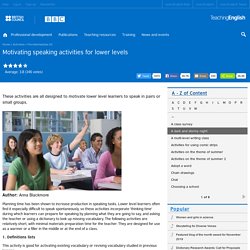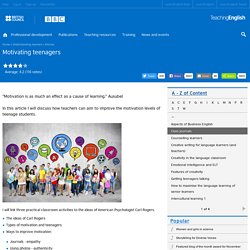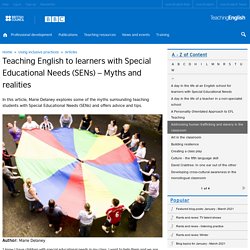

M.Ed. in Differentiation - Sample Lesson. Reconcilable Differences? Standards-Based Teaching and Differentiation. Understanding Differentiated Instruction: Building a Foundation for Leadership. Total physical response - TPR. Where is it from?

How can I use it in class? When should I use it? Why should I use it in the classroom? A few useful variations Are there any disadvantages with using TPR? Where is it from? TPR stands for Total Physical Response and was created by Dr. How can I use it in class? In the classroom the teacher plays the role of parent. It is more effective if the students are standing in a circle around the teacher and you can even encourage them to walk around as they do the action. When should I use it? TPR can be used to teach and practise many things. Vocabulary connected with actions (smile, chop, headache, wriggle) Tenses past/present/future and continuous aspects (Every morning I clean my teeth, I make my bed, I eat breakfast) Classroom language (Open your books) Imperatives/Instructions (Stand up, close your eyes) Storytelling. IATEFL 2018: Safe Speaking Environments - What? Why? How?
Published 9 April 2018 In our first post from IATEFL 2018, we’re sharing the talk from Professor of Psycholinguistics, Zoltán Dörnyei, on what exactly Safe Speaking Environments are and why you should care.

The talk looks at creating a psychological environment in the classroom which might make students’ lives easier. Zoltán says that in order to facilitate speaking in the language classroom, we need to: Create suitable conditions in accordance with the main tenets of group dynamics, andApply the principles of safe speaking environments What conditions need to be in place so we can start implementing a safe speaking environment?
Zoltán talks about group cohesiveness being a very important attribute, which determines the productivity of the group, and the degree of members’ engagement with the group. He looks at eight different factors that promote group cohesiveness, including cooperation, competition and teachers’ leadership styles. 1. 2. 3. See more recordings and articles from IATEFL. Motivating speaking activities for lower levels. Planning time has been shown to increase production in speaking tasks.

Lower level learners often find it especially difficult to speak spontaneously, so these activities incorporate 'thinking time' during which learners can prepare for speaking by planning what they are going to say, and asking the teacher or using a dictionary to look up missing vocabulary. The following activities are relatively short, with minimal materials preparation time for the teacher. They are designed for use as a warmer or a filler in the middle or at the end of a class. 1. Definitions lists This activity is good for activating existing vocabulary or revising vocabulary studied in previous lessons. Procedure Choose a vocabulary topic (this can be vocabulary you have recently studied or a topic you want to introduce). A faster-moving, fun alternative to this activity is a team game. 2. 3. This is a variation on the above activity and is great for practising adjectives. 4. 5. 6.
Motivating the unmotivated. Motivating teenagers. I will link three practical classroom activities to the ideas of American Psychologist Carl Rogers.

The ideas of Carl Rogers Types of motivation and teenagers Ways to improve motivation:Journals - empathy Using photos - authenticity Music - acceptance The ideas of Carl Rogers Rogers (1957) outlined 3 attitudinal qualities that a teacher, or in his words, a facilitator, should have to assist the learning process. They are empathy (seeing things from the students' viewpoint), authenticity (being yourself) and acceptance (of students' ideas and opinions).
Types of motivation and teenagers It is widely agreed that motivation has a great effect on a student's capacity to learn. Motivation can be broken down into extrinsic and intrinsic forms. Ways to improve motivation Journals - Empathy Journal writing can create wonderful opportunities to find out more about your students' lives. Joanna Budden, British Council, Spain. Equal opportunity and diversity: The handbook for teachers of English. Identifying and working with dyslexic students. Teaching English to learners with Special Educational Needs (SENs) – Myths and realities. ‘I know I have children with special educational needs in my class, I want to help them and we are supposed to promote inclusion, but I really am not sure how to do this’ Vera, primary teacher from Spain ‘Some of the children in my class are really badly behaved, they can’t sit still, don’t finish their work and are always calling out.

I think they might have a learning difficulty, but I don’t know what to do’ Kris, secondary teacher from Poland Do you feel like these teachers? Myth 1 – You have to be a specialist psychologist or specially trained teacher to know how to teach these learners No, you don’t. Myth 2 – other learners in the class make less progress when they are taught with learners with SENs No, this is not necessarily the case. Myth 3 – learners with SENs cannot learn languages No, this does not have to be true.
Myth 4 – it takes a lot of extra time and planning No. Myth 5 – a teacher can’t ‘fix’ the learner’s problem so there is nothing I can do Definitely not true. 1. 2. 3. 4.